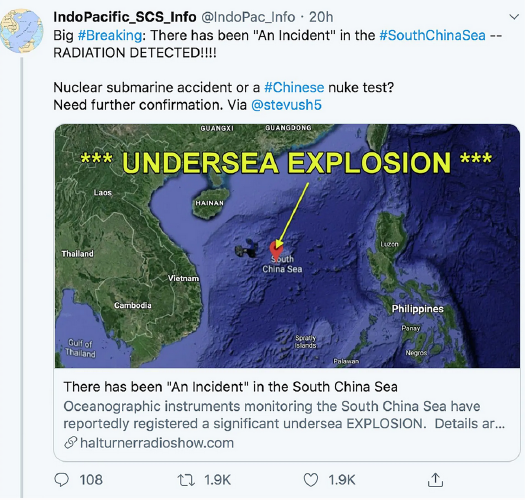A Rumor about the South China Sea Shows the Value of Transparency
On November 22, the Twitter account @IndoPac_Info tweeted that there had been “An incident [sic] in the #SouthChinaSea — RADIATION DETECTED!!!!” speculating that it was “a nuclear submarine or a #Chinese nuke test.”

Don’t worry: everything’s fine. There was no explosion. In fact, the story was a total fabrication. So what did happen?
For reasons that may never be clear, a white nationalist radio host posted the story on his website, which was then picked up by the Twitter account, which is popular with experts on Asian politics, and retweeted nearly 2,000 times. When it was repudiated by experts and officials, the radio host dug in his heels on-air, citing his past as an FBI informant and mass media obstruction.

It’s a familiar narrative, one that causes understandable anxiety about the potential for a range of new threats to scramble conventional thinking about nuclear weapons. There are countless other examples of potentially destructive rumors that start online and quickly spread. In an era where the one person in the United States with the authority to launch a nuclear weapon is undeniably Very Online, it’s all too easy to imagine how a false rumor could precipitate an international crisis.
How can we be sure that this never happens? First, by acknowledging that the risk of nuclear use based on misinterpretation or incorrect information was with us decades before Twitter was invented. A mistake by a well-meaning insider, sunlight reflected off clouds, and a Presidential joke that fell flat have all brought the world close to nuclear use in the past 40 years. Common-sense reforms to business-as-usual among nuclear-armed states, such as adoption of a global No-First-Use agreement, taking nuclear weapons worldwide off high alert, and a return to strategic stability talks by the U.S. and Russia would all go a long way to reducing the risk of nuclear use based on false information.

Now, when more people than ever are directly involved in producing information, it’s foolhardy to believe that the world can be made totally safe from the worst-case scenario of a rumor going nuclear. As long as nuclear weapons exist, the threat of nuclear use is always with us. The only way to avoid nuclear use is to eliminate nuclear weapons once and for all.